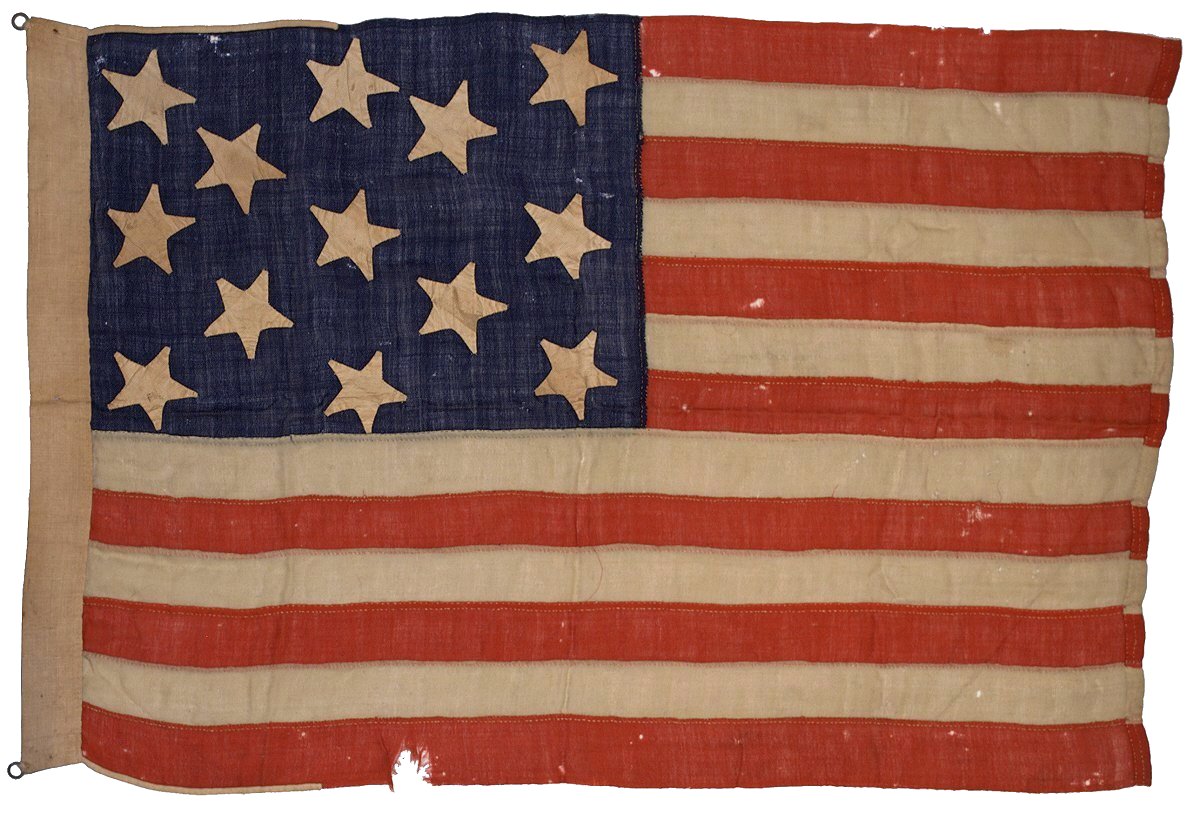
This small hand sewn 13
Star American Flag dates to the period of the Civil War.
It was most likely gifted by a veteran member of the William
H. Bartlett Post No. 3 of the Grand Army of the Republic.
Stenciling on the reverse of the hoist reads:
W. H. BARTLETT
NEW BEDFORD
MASS. and
faint but legible script in period ink reads:
W. H. Bartlett
Nov 9th 1868
Soldiers often gifted flags that were carried or used in
the war to their G.A.R. posts as mementos.
Interestingly, the William H. Bartlett post was actually
formally organized as Post No. 3 in Tauton,
Massachusetts, about 20 miles from the stamped location
of New Bedford, Massachusetts. The post would have served
veterans in the local area that included nearby New Bedford. The
Bartlett Post was named for Captain William H. Bartlett
of Tauton, Massachusetts. Bartlett mustered into
Company G, 4th Massachusetts Regiment, as a Sergeant on
April 22, 1861. This early war enlistment was for
only 90 days, when the nation was optimistic that the
war would be resolved quickly. But with the war
continuing, and enlistments expiring, longer term units
were soon organized. He mustered out of the
service on July 22, 1861, at the end of the 90 days
enlistment with Company G, and immediately re-entered
the service as a Captain in Company K, 4th Massachusetts
Regiment. Captain Bartlett was killed in a grenade
attack during the siege of Port Hudson, Louisiana, on
June 14, 1863. An excerpt in the History of
Bristol County, Massachusetts, describes the sad events:
|
"On the 30th
of May the regiment (with Companies G and K)
left for Port Hudson, where they had a full
share in the siege of that place. On the
14th of June followed the hand-grenade
slaughter of the brave men under Capt.
Bartlett, whose death has been duly noticed,
in the attempt to take that fort. It was one
of the deplorable mistakes of the Banks
campaign, as a few days' time must have
compelled a surrender of the rebels without
the reckless loss of valuable lives,
accomplishing nothing." |
The flag's extremely
small size, at just two feet on the hoist and three feet
on the fly, is very rare. Flags during this period
were typically large, often more than eight feet in
length. The flag is entirely hand sewn, which is a
highly desirable trait in a thirteen star flag of any
period. The wide canvas hoist is interesting and
unusual, and the edge reinforcements that extend from
the hoist along the top and bottom of the flag, to
prevent the wool from tearing from the hoist, are unique
in my experience. The colors of the flag are rich and
vibrant. The canton is a deep blue with a tinge of
purple hue, typical of Civil War era wool flags, and the
red stripes are a deep ruby red color. The
proportions of the canton, being half the length of the
fly rather than typical one-third length, is another
very attractive and striking feature of the flag.
Although it might be suspected that the flag's length
was longer and may have been turned back and
re-stitched, examination shows that the current
proportions of the flag are original and as intended.
The irregular spacing of the stars, with their flat,
blunt tips and haphazard rotation, results in a folky
and beautiful presentation of the Hopkinson patterned
thirteen star flag. 1
History of Bristol County, Massachusetts: With
Biographical Sketches of Many of its Pioneers and
Prominent Men, Part 2; by Duane Hamilton Hurd, Published
by J. W. Lewis & Co., 1883. |

